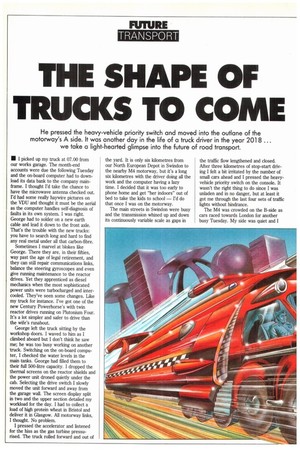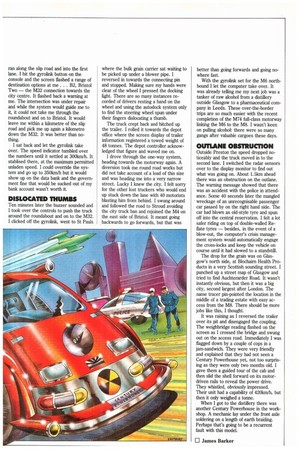THE SHAPE OF TRUCKS TO COME
Page 30

Page 31

If you've noticed an error in this article please click here to report it so we can fix it.
He pressed the heavy-vehicle priority switch and moved into the outlane of the motorway's A side. It was another day in the life of a truck driver in the year 2018 ... we take o light-hearted glimpse into the future of road transport.
• I picked up my truck at 07.00 from our works garage. The month-end accounts were due the following Tuesday and the on-board computer had to download its data bank to the company mainframe. I thought I'd take the chance to have the microwave antenna checked out. I'd had some really haywire pictures on the VDU and thought it must be the aerial as the computer handles self-diagnosis of faults in its own system. I was right. George had to solder on a new earth cable and lead it down to the front axle. That's the trouble with the new trucks: you have to search long and hard to find any real metal under all that carbon-fibre.
Sometimes I marvel at blokes like George. There they are, in their fifties, way past the age of legal retirement, and they can still repair communications links, balance the steering gyroscopes and even give running maintenance to the reactor drives. Yet they apprenticed as diesel mechanics when the most sophisticated power units were turbocharged and intercooled. They've seen some changes. Like my truck for instance. I've got one of the new Century Powerhorse's with twin reactor drives running on Plutonium Four. It's a lot simpler and safer to drive than the wife's runabout.
George left the truck sitting by the workshop doors. I waved to him as I climbed aboard but I don't think he saw me; he was too busy working on another truck. Switching on the on-board computer, I checked the water levels in the main tanks. George had filled them to their full 500-litre capacity. I dropped the thermal screens on the reactor shields and the power unit droned quietly under the cab. Selecting the drive switch I slowly moved the unit forward and away from the garage wall. The screen display split in two and the upper section detailed my workload for the day. I had to collect a load of high protein wheat in Bristol and deliver it in Glasgow. All motorway links, I thought. No problem.
I pressed the accelerator and listened for the hiss as the gas turbine pressurised. The truck rolled forward and out of the yard. It is only six kilometres from our North European Depot in Swindon to the nearby M4 motorway, but it's a long six kilometres with the driver doing all the work and the computer having a lazy time. I decided that it was too early to phone home and get "her indoors" out of bed to take the kids to school — I'd do that once I was on the motorway.
The main streets in Swindon were busy and the transmission whined up and down its continuously variable scale as gaps in the traffic flow lengthened and closed. After three kilometres of stop-start driving I felt a bit irritated by the number of small cars ahead and I pressed the heavyvehicle priority switch on the console. It wasn't the right thing to do since I was unladen and in no danger, but at least it got me through the last four sets of traffic lights without hindrance.
The M4 was crowded on the B-side as cars raced towards London for another busy Tuesday. My side was quiet and I
ran along the slip road and into the first lane. I hit the gyrolink button on the console and the screen flashed a range of destination options at me. . . B2, Bristol Two — the M32 connection towards the city centre. It flashed back a warning at me. The intersection was under repair and while the system would guide me to it, it could not take me through the roundabout and on to Bristol. It would leave me within a kilometre of the slip road and pick me up again a kilometre down the M32. It was better than nothing.
I sat back and let the gyrolink take over. The speed indicator tumbled over the numbers until it settled at 300km/h. It stablised there, at the maximum permitted unladen speed. I could override the system and go up to 350km/h but it would show up on the data bank and the government fine that would be sucked out of my bank account wasn't worth it.
DISLOCATED THUMBS
Ten minutes later the buzzer sounded and I took over the controls to push the truck around the roundabout and on to the M32. I clicked off the gyrolink, went to St Pauls where the bulk grain carrier sat waiting to be picked up under a blower pipe. I reversed in towards the connecting pin and stopped. Making sure my hands were clear of the wheel I pressed the docking light. There are so many instances recorded of drivers resting a hand on the wheel and using the autodock system only to find the steering wheel spun under their fingers dislocating a thumb.
The truck crept back and hitched up the trailer. I rolled it towards the depot office where the screen display of trailer information registered a towed weight of 48 tonnes. The depot controller acknowledged that figure and waved me on.
I drove through the one-way system, heading towards the motorway again. A diversion took me round road works but did not take account of a load of this size and was heading me into a very narrow street. Lucky I knew the city. I felt sorry for the other lost truckers who would end up stuck down the lane with 40 motorists blasting him from behind. I swung around and followed the road to Stroud avoiding the city truck ban and rejoined the M4 on the east side of Bristol. It meant going backwards to go forwards, but that was better than going forwards and going nowhere fast.
With the gyrolink set for the M6 northbound I let the computer take over. It was already telling me my next job was a tanker of raw alcohol from a distillery outside Glasgow to a pharmaceutical company in Leeds. These over-the-border trips are so much easier with the recent completion of the M74 full-class motorway linking the M6 to the M8. I wasn't keen on pulling alcohol: there were so many gangs after valuable cargoes these days.
OUTLANE OBSTRUCTION
Outside Preston the speed dropped noticeably and the truck moved in to the second lane. I switched the radar sensors over to the display monitor to find out what was going on. About 1.51cm ahead there was an obstruction on the outJane. The warning message showed that there was an accident with the police in attendance. Some 40 seconds later the mangled wreckage of an unrecognisable passenger car passed by on the right hand side. The car had blown an old-style tyre and spun off into the central reservation. I felt a lot safer riding on top of double-walled Renate tyres — besides, in the event of a blow-out, the computer's crisis management system would automatically engage the cross-locks and keep the vehicle on course until it had slowed to a standstill.
The drop for the grain was on Glasgow's north side, at Blochairn Health Products in a very Scottish sounding street. I punched up a street map of Glasgow and tried to find Auchterarder Road. It wasn't instantly obvious, but then it was a big city, second largest after London. The name tracer pin-pointed the location in the middle of a trading estate with easy access from the M8. There should be more jobs like this, I thought.
It was raining as I reversed the trailer over its pit and disengaged the coupling. The weighbridge reading flashed on the screen as I crossed the bridge and swung out on the access road. Immediately I was flagged down by a couple of cops in a jam-sandwich. They were very friendly and explained that they had not seen a Century Powerhouse yet, not too surprising as they were only two months old. I gave them a guided tour of the cab and then slid the shell forward on its motordriven rails to reveal the power drive. They whistled, obviously impressed. Their unit had a capability of 420km/h, but then it only weighed a tonne.
When I got to the distillery there was another Century Powerhouse in the workshop. A mechanic lay under the front axle soldering on a length of earth braiding. Perhaps that's going to be a recurrent fault with this model.
I=1 James Barker








































































































